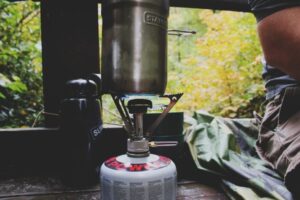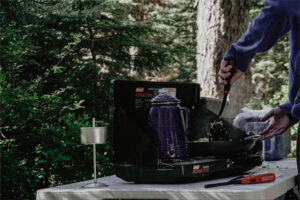
In this article, we have broken down the variety of non-toxic utensils into their materials: wood and bamboo, stainless steel, silicone, glass, and ceramic. This helps to explain the advantages of using non-toxic, sustainable materials to make kitchen utensils, as well as how to maintain and care for them to preserve their longevity.
Wooden & bamboo kitchen utensils
Wooden utensils have had a place in the home kitchen long before plastic and harmful chemicals were created. This is an excellent item to use when seeking for chemical-free, non-toxic solutions in your kitchen. Furthermore, if properly cared for, wooden tools may last a lifetime and even be passed down through generations. Cooking using your grandmother’s antique wooden spoon may offer a whole new level of affection and respect.
Beech, teak, and premium olive wood are common woods used in high-quality cutlery. Tools sculpted from a single piece of wood and hand-carved are more expensive, but they can be one-of-a-kind. Cheap utensils are sometimes fashioned from pine or other untreated woods that may splinter, shatter, or discolour over time. Bamboo is becoming increasingly trendy in the kitchen. Bamboo is sometimes seen as more environmentally friendly than traditional timbers since it grows quickly and can be replanted and regrown at a faster pace than massive teak and beech trees.
Stainless steel kitchen utensils
Stainless steel is the greatest non-toxic metal utensil and food preparation equipment alternative. Stainless steel is a fantastic material for cooking utensils since it is resistant to corrosion and non-reactive. Knives, ladles, sieves, and strainers all benefit from being constructed of sturdy stainless steel so that you can simply cut, serve, transfer, or remove items. Stainless steel utensils, like wooden utensils, may last a lifetime if properly cared for. Though they function well with stainless steel cookware, stainless steel utensils can harm nonstick cookware and even scratch enamel surfaces. Damage to the nonstick layer of cookware reduces its effectiveness over time and increases the chance of chemical leaching from the coating, so keep this in mind if you have a large collection of nonstick pots and pans.
Silicone kitchen utensils
Silicone, a relatively new discovery, has become a handy addition to the home kitchen since it is resistant to high heat, resilient, and ideal for use on nonstick pots and pans. Silicone, like glass, is created from a certain combination of sand and oxygen and is hence fully food-safe, ocean-friendly, and nontoxic. When compared to plastic, which is petroleum-based and typically contains several toxic chemicals to make it stable, silicone is clearly the superior choice. It is crucial to note, however, that not all silicone may be used in the kitchen; make sure the silicone in your utensils is labelled as “food-grade.”
Silicone is naturally nonstick, making silicone utensils ideal for working with oils, sticky batters, and scraping out the leftovers in pan corners. Silicone, in addition to being entirely water-resistant and non-absorbable, is also flexible, which is its key advantage over hard wooden and stainless steel, making it an excellent alternative material for baking tools.
Glass & ceramic kitchen utensils
Glass and ceramic are considered to be ideal materials for high-quality, non-toxic cookware. Brands like Pyrex and Le Creuset make good use of these materials. Though not traditional materials for cooking tools, naturally non-toxic glass and ceramic can create safer, more functional, robust, and eco-friendly alternatives to plastic products such as measuring jugs or storage containers.
Materials to avoid
When purchasing utensils or other goods, it is a good practice to inquire about the materials used. Here are some items to be aware of and actively avoid:
BPA Plastic
Polycarbonate plastics, such as cheap reusable plastic water bottles or food containers, are common sources. Despite the fact that it has been used for many decades, it has recently been shown that BPA can leak from plastic and into liquids or food ingredients over time. This is risky since BPA has been linked to immune, reproductive, and neurological health problems.
Polytetrafluoroethylene (PTFE)
A man-made substance that is commonly found in less expensive nonstick coatings on pots and pans. When shopping for cooking utensils, especially silicone or plastic ones, search for nonstick coatings containing PTFE; this includes many Teflon goods. The major problem is that PTFE has been demonstrated to be unstable at high temperatures, spewing harmful vapours into the surrounding air and food. This chemical reaction has caused people to have flu-like symptoms after being exposed, as well as liver and kidney damage in severe cases.
Nickel
This metal is commonly found in stainless steel and is typically thought to be harmless within the steel. Cheap, outdated, or poorly constructed stainless steel, on the other hand, might leach nickel into the food. Nickel, being a carcinogen, can cause lung damage if exposed to it on a regular basis.
Nylon
Nylon is commonly used for cooking equipment such as spatulas, whisks, tongs, slotted spoons, and many more items. Unfortunately, the substance that makes a utensil suitable for nonstick pans also has hidden health risks.
Conclusion
Toxin prevention should be a concern for everyone, but if you go out of your way to acquire organic fruit and unprocessed foods, you should also make sure you have non-toxic cookware and utensils.
We’ve spoken about quality a lot in this post, and perhaps it’s clear that we feel that focusing on quality when purchasing cookware will help you avoid introducing cheap, hazardous pollutants into your kitchen. The toxic materials stated above were all invented and are frequently utilized to minimize costs so that things may be sold cheaply with little regard for the harm they may bring to individuals and the environment. When purchasing high-quality utensils, you will notice how sturdy, powerful, and robust they are in comparison to cheaper options, letting you know they will last much longer and save you money in the long run.







